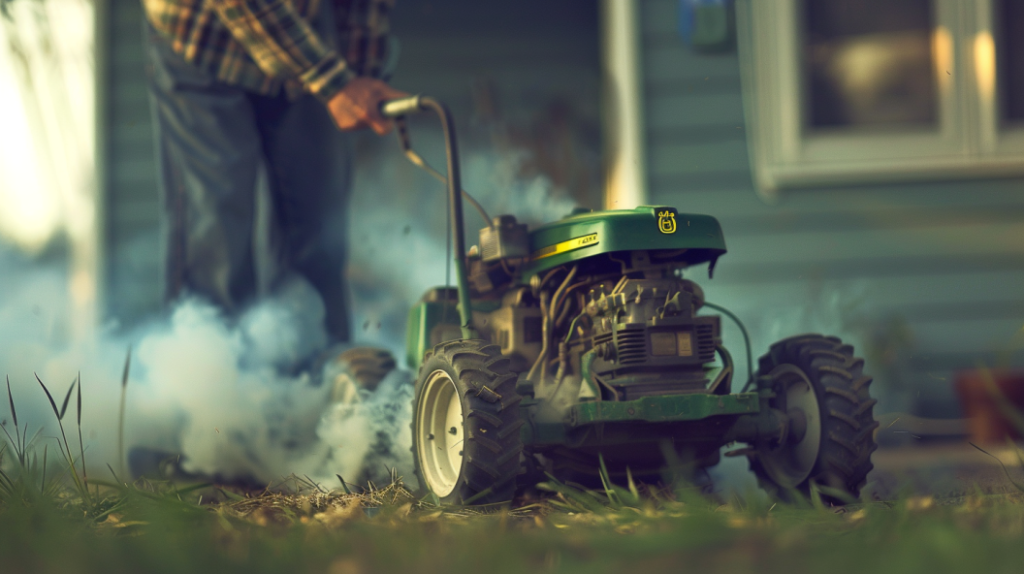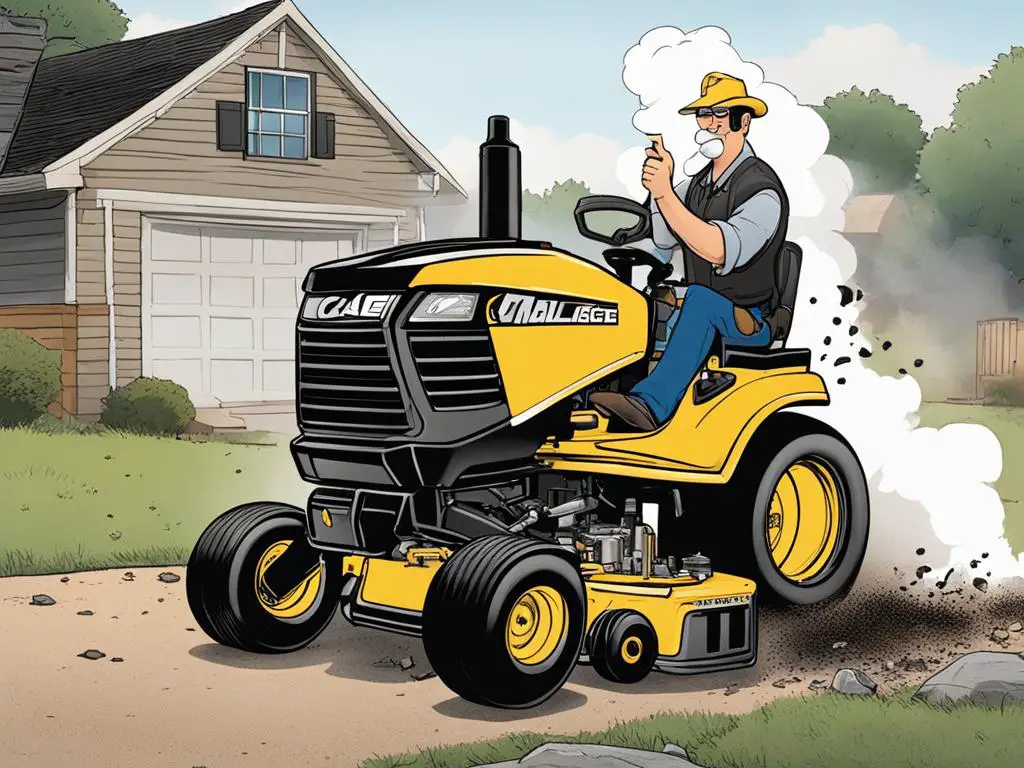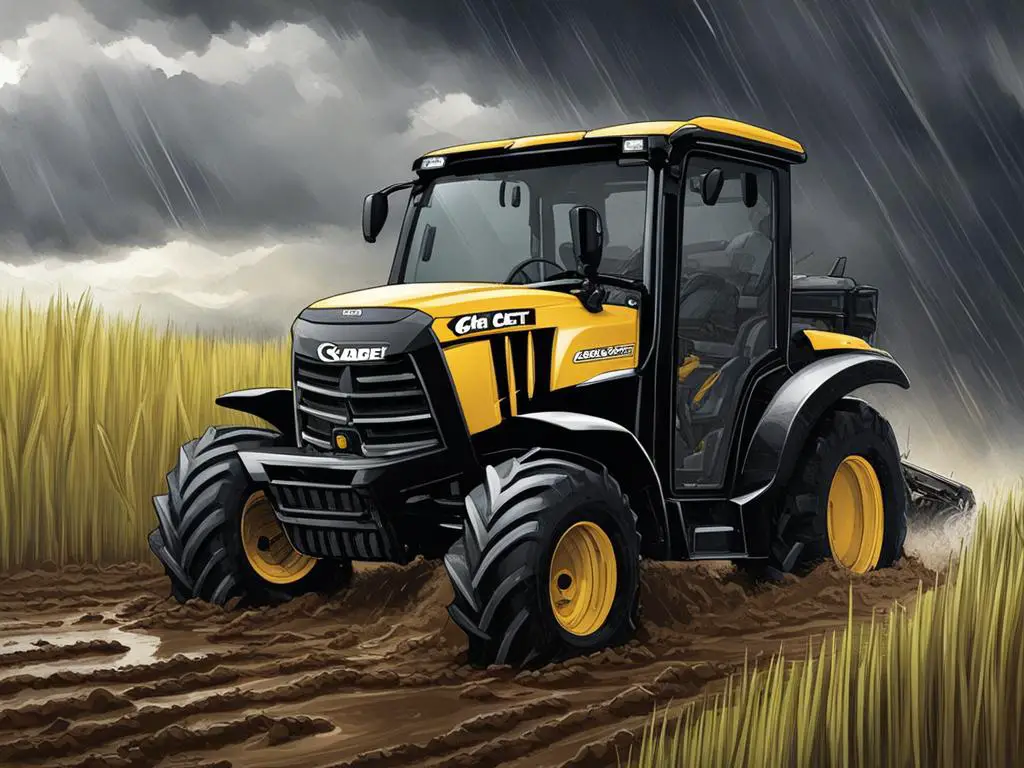If you’ve found yourself facing unexpected challenges with your John Deere S110, you’re not alone. From mysterious engine sputters to perplexing cutting irregularities, the journey to a smoothly running mower can be filled with twists and turns. But fear not, as this troubleshooting guide holds the key to revealing solutions to your lawn mower woes. Stay tuned to uncover practical tips and insights that can help you regain control over your John Deere S110’s performance and keep your yard looking pristine.
Key Takeaways
- Check battery connections, fuel, spark plug, air filter
- Verify blade height, tire pressure, sharpness for cutting
- Inspect alternator belt tension, voltage regulator, wear
- Ensure proper steering alignment, tire pressure, sharp blades
- Address overheating, vibrations with air filter, maintenance
Engine Starting Issues

If you’re encountering difficulties starting the engine on your John Deere S110, check the battery connections and fuel supply for any potential issues. Begin by ensuring that the battery terminals are clean and tightly secured. Loose or corroded connections can prevent the engine from receiving the necessary power to start.
If the battery is in good condition, move on to inspecting the fuel supply. Make sure there’s an adequate amount of fuel in the tank and that the fuel line isn’t clogged or damaged.
Next, check the spark plug to confirm that it’s functioning correctly. A faulty spark plug can hinder the ignition process, causing starting problems. Additionally, examine the air filter for any dirt or debris that may be restricting airflow to the engine. A clean air filter is crucial for efficient engine performance.
Uneven Cutting Performance
When experiencing uneven cutting performance with your John Deere S110, consider checking the blade height adjustment first. Make sure the blade is set to the correct cutting height to guarantee a uniform cut across the lawn.
Additionally, uneven tire pressure can also lead to inconsistent cutting results, so verify all tires are properly inflated.
Blade Height Adjustment
To guarantee peak cutting performance with your John Deere S110 mower, precise adjustment of the blade height is essential for achieving a uniform and clean cut across your lawn. Incorrect blade height can lead to uneven cutting, missed spots, and an overall unkempt appearance of your lawn.
To adjust the blade height on your John Deere S110, locate the height adjustment lever near the wheels. Make sure the mower is on a flat surface before making any adjustments. Lower the cutting deck to the desired height for shorter grass or raise it for longer grass. It’s important to adjust the deck evenly on both sides to maintain a level cut.
Regularly check and adjust the blade height based on the grass growth to maintain an excellent cutting performance. By following these precise adjustments, you can achieve a well-manicured lawn that enhances the overall aesthetics of your outdoor space.
Uneven Tire Pressure
Maintaining consistent tire pressure on your John Deere S110 mower is crucial for guaranteeing uniform cutting performance across your lawn. Uneven tire pressure can result in an imbalanced mower deck, leading to an uneven cut and an unsightly lawn appearance. Here are some key points to keep in mind:
- Check Tire Pressure Regularly: Make it a habit to check the tire pressure on all four wheels before each mowing session. Refer to the user manual for the recommended tire pressure levels.
- Adjust Tire Pressure Equally: If you notice differences in tire pressure between the front and rear tires or the left and right tires, adjust them accordingly to ensure they’re all inflated equally.
- Monitor for Leaks or Damage: Inspect the tires for any signs of leaks, punctures, or visible damage. Address any issues promptly to maintain consistent tire pressure.
Blade Sharpening Needed
Regular blade sharpening is crucial to address uneven cutting performance on your John Deere S110 mower. When the blades become dull or unevenly worn, they struggle to cut grass evenly, leading to an unsightly lawn appearance.
To sharpen the blades, first, make sure the mower is off and the spark plug is disconnected for safety. Remove the blades following the manufacturer’s instructions, typically requiring a socket wrench. Inspect the blades for any major damages that may necessitate replacement.
Using a file or grinder, sharpen the cutting edges at the original angle, maintaining balance on both sides. Check for blade balance by hanging it on a nail; if one side dips, continue grinding until balanced. Reinstall the blades carefully, ensuring they’re securely fastened.
Regularly inspect and sharpen the blades every 25 hours of use or as needed to keep your John Deere S110 performing at its best and your lawn looking pristine.
Transmission Problems

If you’re experiencing transmission problems with your John Deere S110, you might encounter shifting issues such as difficulty changing gears smoothly.
Additionally, you might notice unusual transmission noises during operation, indicating potential internal issues.
Loss of power can also be a common symptom of transmission problems, affecting the overall performance of your mower.
Shifting Issues
Experiencing difficulty shifting gears on your John Deere S110 may indicate underlying transmission problems that require immediate attention. When encountering shifting issues, it’s important to address them promptly to prevent further damage to your mower.
Here are some key points to bear in mind:
- Check Transmission Fluid Levels: Low transmission fluid levels can hinder proper gear shifting. Make sure the fluid is at the recommended level to facilitate smooth transmission operation.
- Inspect Clutch System: A faulty or worn-out clutch can lead to difficulty in shifting gears. Examine the clutch system for any signs of damage or wear and replace components if necessary.
- Adjust Linkage Connections: Misaligned or loose linkage connections can impede the shifting process. Verify that all linkages are properly adjusted and tightened to enable precise gear changes on your John Deere S110.
Transmission Noises
Addressing transmission noises on your John Deere S110 is vital to diagnosing potential transmission problems effectively. Unusual sounds coming from the transmission can be indicative of underlying issues that require attention.
When you hear grinding, whining, or clunking noises during operation, it’s important to investigate the source promptly to prevent further damage.
Grinding noises often suggest worn gears or low transmission fluid levels, which can lead to increased friction and component wear. Whining sounds may indicate issues with the bearings or internal components that aren’t functioning correctly. Clunking noises could signal loose or damaged parts within the transmission system that need immediate inspection.
To troubleshoot transmission noises on your John Deere S110, start by checking the transmission fluid levels and condition. Make sure that all components are properly lubricated and tightened according to the manufacturer’s specifications.
If the noises persist, consider seeking professional assistance to diagnose and resolve any potential transmission problems effectively. Preventative maintenance and timely repairs are key to keeping your John Deere S110 running smoothly.

Loss of Power
Loss of power in your John Deere S110 may be a symptom of transmission problems that require prompt attention and diagnosis. When your mower experiences a loss of power, it can greatly impact its performance and efficiency.
To address this issue effectively, consider the following:
- Check Transmission Fluid Levels: Low transmission fluid levels can lead to decreased power output. Confirm the fluid is at the correct level to maintain peak performance.
- Inspect Drive Belt: A worn or damaged drive belt can result in power loss as it hampers the transfer of power from the engine to the transmission. Replace the belt if necessary.
- Examine Transmission Components: Faulty transmission components such as gears or clutches can cause power loss. A thorough inspection of these parts can help identify any issues that need to be resolved promptly.
Battery Not Charging
If your John Deere S110 is exhibiting the issue of the battery not charging, it may be due to a faulty alternator. The alternator is responsible for converting mechanical energy into electrical energy to charge the battery.
Start by checking the alternator belt for proper tension and any signs of wear. A loose or damaged belt can prevent the alternator from functioning correctly.
Next, inspect the alternator for any visible damage or loose connections. Tighten any loose connections and replace the alternator if necessary.
Additionally, check the voltage regulator to make sure it’s regulating the correct voltage output to charge the battery effectively. Testing the alternator output with a multimeter can help determine if the alternator is functioning within the manufacturer’s specifications.
Belt Slipping or Breaking
Inspect the belt on your John Deere S110 for signs of slipping or wear to prevent potential issues with belt breakage. Belt slipping or breaking can lead to a loss of power transmission and functionality in your mower.
Here are some steps you can take to troubleshoot and address this problem:
- Verify Tension: Verify that the belt tension is within the manufacturer’s recommended range. A loose belt can slip and eventually break under load.
- Examine for Wear: Look for any signs of wear such as fraying, cracking, or stretching. Replace the belt if you notice any of these issues to prevent it from breaking during operation.
- Clean Pulleys: Dirt and debris buildup on the pulleys can cause the belt to slip. Regularly clean the pulleys to maintain proper traction and prevent slipping.
Steering Difficulties
To troubleshoot steering difficulties on your John Deere S110, start by checking the alignment of the front wheels. Incorrect alignment can cause steering issues. Verify that the wheels are facing straight ahead when the steering wheel is centered. If alignment is off, adjust the tie rods to align the front wheels properly.
Next, inspect the steering components for any signs of damage or wear. Check the steering gear, linkages, and joints for looseness or damage. Tighten any loose components and replace any damaged parts to guarantee smooth steering operation.
Additionally, check the tire pressure on all four wheels. Uneven tire pressure can lead to steering problems. Adjust the tire pressure according to the manufacturer’s recommendations to maintain even pressure on all tires.
Lastly, lubricate the steering system. Proper lubrication of the steering components will reduce friction and make steering easier. Use a high-quality lubricant recommended for your John Deere S110 to keep the steering system functioning smoothly.
Poor Mulching Results

Experiencing poor mulching results with your John Deere S110 may indicate issues with blade sharpness or deck height adjustment. When mulching isn’t up to par, consider the following:
- Blade Sharpness: Dull blades can tear grass instead of cleanly cutting it, leading to uneven mulching. Regularly sharpen or replace blades to guarantee a clean cut for effective mulching.
- Deck Height Adjustment: Incorrect deck height can affect how well your mower mulches. Make sure the deck is set at the recommended height for best mulching performance.
- Clogged Deck: A clogged mower deck can hinder proper mulching by obstructing the flow of grass clippings. Regularly clean out any debris or grass buildup underneath the deck to avoid mulching issues.
Overheating Concerns
Inadequate air circulation around the engine may contribute to overheating issues in your John Deere S110 mower. When the engine overheats, it can lead to serious damage if not addressed promptly. To help you troubleshoot this problem, check the following:
| Potential Cause | Solution |
|---|---|
| Clogged Air Filter | Replace or clean the air filter. |
| Dirty Cooling Fins | Clean the cooling fins to improve heat dissipation. |
| Debris Blocking Airflow | Remove any debris obstructing the airflow. |
Regularly inspecting and maintaining these components can prevent overheating and ensure peak performance of your mower. Additionally, make sure that the engine is not overloaded, as this can also cause overheating. If the issue persists after checking these factors, it is recommended to consult a professional technician for further diagnosis and repair. By addressing overheating concerns promptly, you can prolong the lifespan of your John Deere S110 mower and keep it running smoothly during operation.
Excessive Vibration Issues
Frequent excessive vibrations in your John Deere S110 mower may indicate underlying issues that require attention to ensure peak performance. When left unresolved, excessive vibrations not only affect the comfort of your mowing experience but can also lead to further damage to the mower’s components.
Here are some key factors to take into account when troubleshooting excessive vibration problems:
- Blade Balance: Check if the blades are properly balanced as unbalanced blades can cause significant vibrations during operation.
- Loose or Worn Parts: Inspect for loose or worn-out components such as blade bolts, pulleys, or mandrels that could be contributing to the excessive vibrations.
- Uneven Terrain: Operating the mower on uneven terrain can also result in increased vibrations, so adjusting your mowing pattern or terrain selection can help alleviate this issue.
Frequently Asked Questions
How Often Should I Sharpen the Blades on My John Deere S110 Mower?
You should sharpen the blades on your John Deere S110 mower every 25-30 hours of use. Regular blade maintenance guarantees a clean, precise cut and promotes the health of your lawn.
Dull blades can tear grass instead of cleanly cutting it, leading to an uneven appearance and potential lawn health issues. Keep a keen eye on blade sharpness to maintain peak performance and the overall look of your lawn.
Can I Use Regular Gasoline in My John Deere S110 Engine?
Sure, you can confidently utilize regular gasoline in your John Deere S110 engine. John Deere designs their engines to efficiently run on this standard fuel type. Remember to always adhere to the manufacturer’s guidelines for fuel octane levels and avoid using old or stale gasoline to guarantee peak engine performance.
Regularly check and maintain your fuel system to keep your John Deere mower running smoothly and efficiently.
What Is the Recommended Maintenance Schedule for the S110 Model?
For the S110 model, it’s recommended to follow a strict maintenance schedule to guarantee peak performance.
Regularly change the engine oil, air filter, and spark plug. Check and adjust tire pressure, lubricate moving parts, and inspect the blades for wear.
Clean the mower deck after each use to prevent grass buildup.
Stay on top of these tasks to keep your John Deere S110 running smoothly and efficiently.
Are There Any Specific Storage Instructions for the John Deere S110?
When storing your John Deere S110, make sure it’s in a dry, well-ventilated area. Clean the machine thoroughly, remove any debris, and inspect for damage.
Add fuel stabilizer to prevent fuel deterioration. Disconnect the battery and store it in a cool place.
Keep the equipment covered to shield it from dust and moisture.
Following these storage instructions will help maintain the quality and longevity of your John Deere S110.
How Do I Adjust the Cutting Height on My John Deere S110 Mower?
To adjust the cutting height on your John Deere S110 mower, it’s as simple as turning the height adjustment knob, much like tuning a radio to find the perfect station.
Locate the knob near the front wheels and rotate it to your desired cutting height. Make sure both sides are adjusted equally for an even cut.
Remember to refer to your manual for specific height settings based on your lawn’s needs.
Conclusion
To sum up, addressing the issues with your John Deere S110 lawn mower is like maneuvering through a well-maintained garden – with the right tools and knowledge, you can guarantee smooth operation and a beautifully manicured lawn.
By tackling engine starting, cutting performance, transmission, battery, belt, steering, mulching, overheating, and vibration issues effectively, you can keep your lawn mower running smoothly and effortlessly.
Remember, a well-maintained machine leads to a well-tended lawn.


